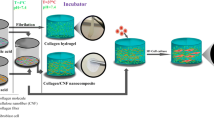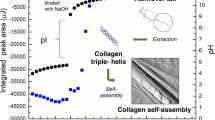Abstract
Pure collagen materials are expensive with poor mechanical properties, which need modifications in most cases. As the degradation product of collagen, gelatin is cheap, degradable and biocompatible, but few literatures have reported the research about gelatin-collagen composite materials. This is because gelatin and collagen have different soluble temperatures—gelatin is soluble in hot water (≥30 °C) and swells in cold water. However, a low temperature (2–10 °C) is required to prepare and store collagen solution, and neutral collagen solution denatures quickly above the room temperature. In this study, gelatin was ground into powders and swelled in neutral bovine tendon pepsin-soluble collagen solution (BPSC) to form a homogeneous gelatin-collagen mixture, in light of the swelling characteristics of gelatin in cold water. The assembly properties and gel properties of this composite material were further studied. Sodium dodecyl sulfate-polyacrylamide gel electrophoresis (SDS-PAGE) test results showed that the bovine tendon collagen had typical type-I collagen structural characterizations with two α chains of about 100 kDa and one β chain of about 200 kDa; while the SDS-PAGE pattern of gelatin displayed bands continuously distributed from 30 to 200 kDa. Amino acid composition analysis test indicated that the content of polar amino acids and the sum of acidic and base amino acids for gelatin were higher than that of BPSC. Studies on gel properties demonstrated that gelatin-collagen mixed solution had collagen-like assembly characteristics and assembly kinetics. The moduli of the assembled gel at 35 °C were equivalent to that of pure bovine tendon collagen system; moreover, the system moduli didn’t change with time with elastic moduli (G′) of about 40 Pa. However, at 25 °C, the moduli of gelatin-collagen composite hydrogel increased with the extension of time, its G′ increased about 18 times within 8 h, and the ratio of elastic modulus to viscous modulus (G″) increased 4.6 times, showing a significant aging effect of structural strength. Meanwhile, the mechanical strength of the composite hydrogel was also regulated by temperature—the gel was highly elastic (G′≈3,000 Pa, G′>>G″) at a low temperature (5 °C); as the temperature rose, the system moduli gradually decreased and the elastic gel transformed into waterlike fluid at 50 °C little by little. What’s more, gelatin-collagen composite hydrogel also had reversible sol-gel performances and self-healing capability similar to the gelatin hydrogel. This novel preparation method for preparing composite materials and the resultant composite hydrogel are expected to be used in the fields of natural food gels, injectable hydrogels, cell scaffolds, drug sustained-release materials and so on, and improve and promote the processing performances, price and large-scale production of collagen-based materials.

Similar content being viewed by others
References
L. Duan, W. Liu, Z. Tian, C. Li, and G. Li, Int J. Biol. Macromol., 69, 482 (2014).
Y. Kawaguchi, E. Kondo, N. Kitamura, K. Arakaki, Y. Tanaka, M. Munekata, N. Nagai, and K. Yasuda, J. Mater. Sci. Mater. Med., 22, 397 (2011).
S. Chen, T. Ikoma, N. Ogawa, S. Migita, H. Kobayashi, and N. Hanagata, Sci. Technol. Adv. Mater., 11, 035001 (2010).
V. Ferraro, B. Gaillard-Martinie, T. Sayd, C. Chambon, M. Anton, and V. Santé-Lhoutellier, Int. J. Biol. Macromol., 97, 55 (2017).
B. Wei, Z. Zhai, H. Wang, J. Zhang, C. Xu, Y. Xu, L. He, and D. Xie, J. Agr. Food Chem., 66, 9080 (2018).
M. Cassagne, K. Pierné, S. D. Galiacy, M. P. Asfaux-Marfaing, P. Fournié, and F. Malecaze, J. Refract. Surg., 33, 290 (2017).
L. Dai, J. Nan, X. Tu, L. He, B. Wei, C. Xu, Y. Xu, S. Li, H. Wang, and J. Zhang, Cellulose, 26, 6713 (2019).
Z. Zhai, H. Wang, B. Wei, P. Yu, C. Xu, L. He, J. Zhang, and Y. Xu, Macromol. Res., 26, 609 (2018).
X. Tu, X. Chen, Y. Peng, J. Nan, B. Wei, L. He, C. Xu, Y. Xu, D. Xie, J. Zhang, and H. Wang, Macromol. Res., 26, 1233 (2018).
J. Zhang, B. Wei, L. He, C. Xu, D. Xie, K.-W. Paik, and H. Wang, Macromol. Res., 25, 1105 (2017).
A. A. Mariod and H. F. Adam, Acta Sci. Pol., Technol. Aliment, 12, 135 (2013).
A. J. A. M. Ribeiro, A. C. Gomes, and A. M. Cavaco-Paulo, J. Biomed. Mater. Res. B, 100, 2269 (2012).
G. Vozzi, C. Corallo, S. Carta, M. Fortina, F. Gattazzo, M. Galletti, and N. Giordano, J. Biomed. Mater. Res., Part A, 102, 1415 (2014).
J. Nan, M. Zou, H. Wang, C. Xu, J. Zhang, B. Wei, L. He, and Y. Xu, Int. J. Biol. Macromol., 111, 200 (2018).
B. Wei, J. Nan, Y. Jiang, H. Wang, J. Zhang, L. He, C. Xu, Z. Zhai, D. Xie, and S. Xie, Food Biophys., 12, 422 (2017).
W. M. Kulicke and R. S. Porter, Rheol. Acta, 19, 601 (1980).
J. Yang, H. Wang, L. He, B. Wei, C. Xu, Y. Xu, J. Zhang, and S. Li, Macromol. Res., 27, 1124 (2019).
J. Josse and W. F. Harrington, J. Mol. Biol., 9, 269 (1964).
M. Sun, X. Wei, H. Wang, C. Xu, B. Wei, J. Zhang, L. He, Y. Xu, and S. Li, Food Bioprocess Technol., 13, 367 (2020).
Y. Tabata and Y. Ikada, Adv. Drug Deliv. Rev., 31, 287 (1998).
Q. Chen, L. Zhu, C. Zhao, Q. Wang, and J. Zheng, Adv. Mater., 25, 4171 (2013).
X. Li, J. Shang, and Z. Wang, Assembly Autom., 37, 170 (2017).
P. Gruet, P. Maincent, X. Berthelot, and V. Kaltsatos, Adv. Drug Deliv. Rev., 50, 245 (2001).
L. Lin, B. Yan, J. Yang, L. Chen, and H. Zeng, Adv. Mater., 27, 1294 (2015).
Author information
Authors and Affiliations
Corresponding author
Additional information
Publisher’s Note Springer Nature remains neutral with regard to jurisdictional claims in published maps and institutional affiliations.
Acknowledgments: This work was supported by the Scientific Research Project of Hubei Provincial Department of Education (Q20181801, Q20191601), School Project of Wuhan Polytechnic University (2019y08), National Natural Science Foundation of China (No. 21676208), Natural Science Innovation Group Project of Hubei Province (2018CFA030), Nature Science Foundation of Hubei Province (No. 2017CFB507, 2018CFA030), Wuhan Morning Light Plan of Youth Science and Technology (No. 2017050304010326), Applied Basic Frontier Project of Wuhan Science and Technology Bureau (2019020701011478).
Supporting Information
Rights and permissions
About this article
Cite this article
He, L., Li, S., Xu, C. et al. A New Method of Gelatin Modified Collagen and Viscoelastic Study of Gelatin-Collagen Composite Hydrogel. Macromol. Res. 28, 861–868 (2020). https://doi.org/10.1007/s13233-020-8103-3
Received:
Revised:
Accepted:
Published:
Issue Date:
DOI: https://doi.org/10.1007/s13233-020-8103-3




